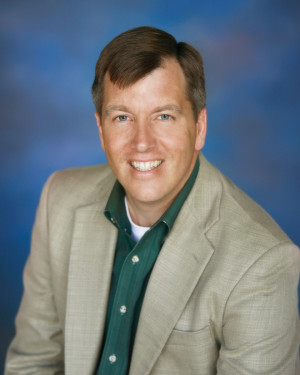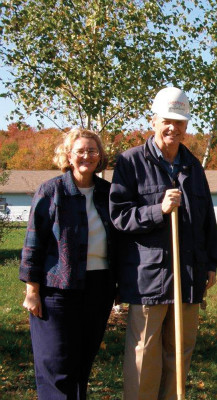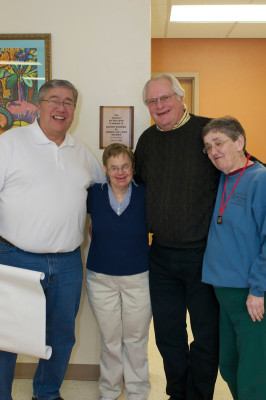The Art of a Door County Capital Campaign
- Share
- Tweet
- Pin
- Share

Many of us often say that Door County is a special place. Indeed it is, particularly when it comes to charitable giving. Our level of charitable giving is far greater than you would normally find in a community with less than 30,000 permanent residents. There are few counties across the Midwest in which such an enormous percentage of giving comes from people who live in a community only a few months out of the year.

“It’s not rocket science, but it involves a lot of hard work.” – Allin Walker, former Executive Director, Peninsula School of Art.
Of course, for charitable organizations with aspirations of offering greater levels of service to Door County, this presents both an opportunity and a challenge. The people of our community have a great tradition of being generous, but our seasonal nature creates unique challenges in motivating them to give to a particular organization.
We set out to study some of the most significant capital campaigns over the last decade in an effort to learn from their success – and share those lessons.
Plan to be Successful
Without exception, every successful capital campaign of the last decade that we examined involved a tremendous amount of planning before the first dollar was raised. This may sound like stating the obvious, but the local charities we talked with took great pains to stress the extreme importance of good planning.
Mike Herlache, Executive Director of the Door County Medical Center Foundation, credits good planning for much of the success they’ve had in raising $11 million for different capital projects at the hospital over the last 10 years.
“If you’re looking to raise big time dollars, you better have that development plan and strategy worked out at least a year ahead of time,” says Herlache. “You really need to do a feasibility study to figure out what is a realistic goal and understand what your stories will be to motivate people to give. You won’t be successful without it.”
Developing a deep understanding of how the organization is generally perceived by potential donors, and getting an initial overview of their thoughts on the proposed capital project, is key for any capital campaign planning process. The charity must assess the capacity and willingness of those donors to give to the project. The organization must also do an honest analysis of the capacity of its staff, board and volunteers to build a vibrant network of relationships, to cultivate those connections, and ultimately to realize major gifts.

“Giving a significant amount of money is a person decision, so there has to be some sort of emotional satisfaction.” – Alan Kopischke, Development Director, Peninsula Players Theatre.
Every successful Door County campaign we looked at began by gathering the information commonly found in a feasibility study, and the executives of these organizations attribute the feasibility study and the corresponding planning process as the essential ingredient in their success. However, practices varied greatly as to how the information was actually gathered.
Paul Kok was Executive Director of Sunshine House during two capital campaigns which together raised about $2.5 million. Kok is a firm believer in the value of hiring professional fundraising counsel when undertaking a capital campaign.
“It was my intuition that the community would support us, but I had nothing to base that feeling on,” says Kok. “Actually going out – doing the interviews with the influential and key players – was really important because it was a neutral source asking the questions about the reputation of Sunshine House, the capacity of the individual being interviewed to support it, and their perception of our organization. It was a significant expense, but it was worth it.”
Cindy Weber, Vice President of Mission Development at the Door County YMCA, agrees wholeheartedly. The YMCA always used outside counsel to raise the roughly $7.5 million in capital campaigns over the last decade. “The consultants do a good job offering an outside perspective and helping to keep you on task,” says Weber. “It’s not cheap, but we believe it’s a worthwhile investment.”
Some charities, however, believe that you don’t need outside counsel to conduct a feasibility study or play any role in a capital campaign. These people say the key is that someone must have the

“My philosophy on fundraising is 99 percent on developing your stories, and 1 percent on actually asking for money.” – Mike Herlache, Executive Director, Door County Medical Center Foundation.
knowledge of how to gather the preliminary planning information and conduct a campaign, but it doesn’t have to be a fundraising consultant.
At Birch Creek Music Performance Center, they drew from the experience of their board of directors and other staff members to raise about $3 million for building expansions and new construction in 2008. “We decided not to hire a consultant and to do it internally,” says Executive
Director Kaye Wagner. “We had people on the board who had been through campaigns in other communities, and that gave us the confidence that we could do it here. They coached the rest of us through it. We saved a lot of money.”
Jane Stevenson was the Campaign Chair at Bay View Lutheran Church when they raised about $750,000 to expand their education wing. She believes that it can be invaluable for the campaign’s volunteers to conduct the feasibility study internally. “We did the feasibility study ourselves,” says Stevenson. “We talked to the congregation and, as a result, we changed our plan. We thought it would be better to talk member-to-member rather than hire an outside consultant.”
There is no right or wrong way to gather the information contained in a typical feasibility study, but everyone agrees that collecting good information and preparing properly is essential to the success of a capital campaign.
Make a Visceral Connection
By definition, capital campaigns involve the construction of something. And who doesn’t like talking about something shiny and new? Charities are usually very good at showing their donors pictures of the new building and can talk in great detail about all of its amenities. But often lost in that technical detail is a discussion of how the new facility will touch the lives of those the charity serves. In other words, too often non-profits forget to connect with our donors on a visceral level.
Alan Kopischke is Development Director of the Peninsula Players, an organization that raised nearly $6.5 million for the construction of a new theater and related buildings. He believes strongly that a charity must go beyond a campaign’s technical and financial details and make a human connection to the donor. “Giving a significant amount of money is a personal decision,” says Kopischke, “so there has to be some sort of emotional satisfaction.”

“The seasonal nature of our business made things difficult for us.” – Kaye Wagner, Executive Director, Birch Creek Music Performance Center.
One of the challenges charities face is that the message which resonates with one potential donor might not touch the heart of another at all. This requires the charity to be flexible enough to touch upon several different chords within the context of the overall theme of the campaign.
For example, an effort to preserve a forest might appeal to one group of donors because they love taking long walks among the trees. A different set of donors might not care about the trees at all, but are motivated by the fact that the forest is a habitat for the birds they love. The goal remains the same for both donors – to preserve the forest – but sometimes you need to use very different messages for different groups of donors. You need to strike the right chord with the right donor so that your message resonates.
“It’s important that we spend less time asking, and more time coming up with compelling stories and figuring out who to tell the story to,” says Herlache. “My philosophy on fundraising is 99 percent on developing your stories, and 1 percent on actually asking for money.”
Of course, that’s easier said than done. It takes a lot of time and homework to match up the correct story with the right donor.
“It’s not rocket science, but it involves a lot of hard work,” says Allin Walker, who was the executive director when the Peninsula School of Art raised more than $1.2 million to build their current facility. “You need to do your research, talk with your board and existing donors who know the [potential donor], and figure out why this [person] would care about your campaign.”
Approach Leadership Donors Before Launching a Public Campaign
The first donors any capital campaign should approach are those who know the organization best. That begins with the charity’s board of directors and its professional staff. The rationale for doing so is simple. If the people who know the organization best aren’t motivated to give, why should anyone else donate? Although the dollar value of the gifts of these “true believers” might be modest, they have immense value as a tool to encourage donations from those with a much greater capacity to give.
“I use the internal campaign to demonstrate to the major donors the importance of what we do,” says Herlache. “I can go to a major donor and say I’ve got all these staff and board donors, and I use that to inspire major donors to give as well.”
While these successful Door County charities might differ as to the precise time they should “go public” and raise more modest gifts from the community at large, there is absolute agreement that it doesn’t come until the campaign is at least halfway to its goal. In fact, some local organizations say it should wait until 90 percent of the goal is met. The early focus should be on those donors with the largest capacity to give. The public part of a capital campaign comes much later.
Whether you should wait to go public until you’re at 50 percent of your goal, or 90 percent, the same rationale is used to explain why you should wait before engaging the community as a whole.

“I think there is so much potential it’s unbelievable, but we can’t expect people simply to give to us because we’re here. We have to build the case that we’re worthy of their support.” – Cindy Weber, Vice President of Mission Development, Door County YMCA.
Every donor wants to feel that his or her gift makes a difference. Imagine that a particular donor is not a “true believer” but has been inspired nonetheless by your work. This person is willing to consider a gift of $5,000, which would be the single largest gift they’ve ever made to charity. But your campaign is $2 million from your goal. Considering how far you still have to go, that $5,000 gift might seem inconsequential to both the charity and the potential donor. In this situation, it is very common to see a donor make a more modest gift of perhaps a few hundred dollars, if they make any gift at all.
If a donor (outside of the “true believers”) is to make a gift that is significant relative to their personal wealth, they usually want it to be significant relative to the campaign as well.
Consider how this same donor might react if you approach them when your campaign is just $200,000 from your goal. All of a sudden that gift of $5,000 is of critical importance and makes a significant dent in the amount left to raise. The only thing that changed was the point during the campaign when you approached this particular donor. Yet by timing the request properly, the donor is left with the feeling – and reality – that their gift was an essential part of the campaign achieving its goal.
But there are other reasons to focus your early energies on major donors as well. A good charity is always aware of the energy levels and enthusiasm of their campaign volunteers.
“Some non-profits spend all kinds of time and volunteer hours selling brats to make a thousand bucks,” says Herlache. “If they would spend that same time simply talking with a few major donors they’d have so much more money for the same amount of work.”
Just like every donor wants their gift to be valued, every volunteer wants to see that their labor is making a difference. Once again consider the campaign that is $2 million away from their goal. Using countless volunteer hours to chase down a few thousand dollars of donations can be disheartening. The volunteers can quickly become disenchanted with the entire campaign when they consider all the work they’ve been doing but see so little progress toward the overall goal.
Focusing those same early volunteer hours toward the cultivation of relationships with potential major donors can have exactly the opposite effect. With each individual major gift enormous and visible progress is being made toward the final goal. That energizes volunteers and they feel like their efforts are being validated through the realization of these major gifts.

(Left to Right) Jim Meyer, Amelie P., Paul Kok and Darlene K. “Endowment funds are typically harder to raise money for because people tend to want to do direct service, but our endowment at Sunshine House is an important part of sustaining our work.” – Jim Meyer, President/CEO, Sunshine House.
Ultimately, the best rationale for starting with major donors is a tautology. You focus a capital campaign on those with the greatest capacity to give because they have the greatest capacity to give. “Ninety percent of our capital dollars come from donors who contribute at least $25,000,” notes Herlache. “Therefore, we should spend 90 percent of our time developing those relationships.”
“In Door County, you have to get some portion of those great philanthropists to believe in your campaign if you hope to meet your goal,” says Walker. “You start by finding one of those people who believe in your cause and you build around that.”
It should be noted that without exception, the leaders of every charity we talked with expressed a deep appreciation for donors at every level. The question is not whether the community at large has a role to play in a capital campaign. The question is when should they be asked to play it.
Remember the Unique Aspects of Charity in Door County
One of the things that makes Door County unique is the incredible number of seasonal residents and retirees who have considerable experience with larger charities in their primary home communities. That knowledge has created a donor base that has a much better understanding of how philanthropy works.
For example, several people affiliated with these successful campaigns stressed how critical an endowment can be when operating the new building once the capital campaign is complete, but building an endowment can be a real challenge.
“Endowment funds are typically harder to raise money for because people tend to want to do direct service,” says Jim Meyer, the current President/CEO of Sunshine House. “But our endowment at Sunshine House is an important part of sustaining our work.”
The YMCA has found the donors of Door County are receptive to the integration of the endowment into their capital campaigns. Their outside fundraising consultants even commented how surprised they were at the sophistication of Door County residents.
“In every capital campaign we have, we want part of our money to go toward the endowment because we need to maintain these buildings,” says Weber. “I think that Door County’s donors understand that it’s not just constructing a building, it’s making sure that we can run the programs inside of those buildings.”

“We did the feasibility study ourselves, we talked to the congregation and, as a result, we changed our plan. We thought it would be better to talk member-to-member rather than hire an outside consultant.” – Jane Stevenson, Campaign Chair, Bay View Lutheran Church.
Door County’s seasonal nature also creates stresses for our local charities that don’t exist in other communities. Our non-profit organizations offer the same amount of services and must conduct the same amount of donor cultivation as in any community, but in Door County most of that work is compacted into about six months.
“The seasonal nature of our business made things difficult for us,” says Wagner. “We’re so busy during the summer with our programming that it was difficult to talk with donors.”
As a result, for a campaign to be successful in Door County, the charity’s board has to be ready to invest considerable amounts of staff and volunteer time.
“The board has to commit the staff’s time to running an effective campaign, whether that’s to hire an assistant or to take on some of the administrative duties,” says Walker. “You’re taking on all this additional work with the campaign, but you still have to offer your programs. It’s a lot of work to be divided up in a short window of time.”
But Door County does offer one advantage over most other communities when it comes to fundraising. The research psychologists tell us that charitable giving at the highest levels is a manifestation of love for one’s community. If that’s true, it bodes well for the future of Door County.
The vast majority of our residents, both seasonal and year round, love living in Door County. Our people have a visceral, deeply personal connection to this place, so it’s no wonder that our community is so generous.
Virtually every type of charity found in Door County is larger and more successful than their counterparts in comparably sized communities. We have two YMCA facilities when many counties don’t even have one. Our little county has an art school, a music school, and several performing arts venues. Virtually every one of our parks has a “friends” group raising money to sustain and enhance it. And Door County is home to several environmental preserves.
Herlache adds, “Per capita, we raise far more money than any other hospital [in the Ministry Health Care system in Wisconsin].”
Charity is a vibrant and important part of our community and our economy. But that begs the question, can we continue to afford it?
Can We Cultivate the Next Generation of Donors?
From a purely statistical perspective, the numbers suggest that we can.
Community foundations from across Wisconsin banded together and commissioned the “Wealth in Wisconsin” study, published in 2005. It found that of Wisconsin’s 72 counties, Door was the second wealthiest in the state, trailing only Ozaukee County. Door County’s current net worth per household is almost 60 percent higher than the state average. It seems pretty clear that Door County has the financial mea ns to support a high level of charitable activity.
ns to support a high level of charitable activity.
The study further estimated that in the first half of the 21st century, approximately $5.2 billion of wealth in Door County will be transferred from one generation to the next. That is a per capita rate which is almost 70 percent above the Wisconsin state average. Imagine if every family’s estate, regardless of the size, donated just 10 percent to charity. That would translate into more than half a billion dollars for our charitable causes over a 50-year span.
Among the local non-profits that have run successful capital campaigns, there is nearly a universal belief that Door County can afford it. But they also recognize that the charities can’t just expect people to be generous. They have to work hard and earn it.
“I think there is so much potential it’s unbelievable,” says Weber, “but we can’t expect people simply to give to us because we’re here. We have to build the case that we’re worthy of their support.”
The concern voiced most often by these charitable professionals is that a generation of great philanthropists is slowly leaving us, but not enough replacements have stepped forward.
“The question is how do you reach that next generation of wealth,” says Walker. “They’re not big events people, they’re not on the cocktail circuit, and they don’t have a strong history of giving in our community yet, but we need them to step up into leadership positions.”
Engaging the next generation of wealth so that they become our newest philanthropists is still a work in progress. In the grand scheme of things, however, it’s a pretty good problem to have.
Photography by Len Villano.


